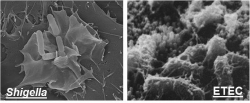Novel vaccines against major enteric pathogens
Shigella and enterotoxigenic Escherichia coli (ETEC) are – alongside rotavirus – the leading pathogens in children below age five. Both pathogens of the Enterobacteriacea family cause dysentery, a severe inflammatory, bloody diarrhea, due to invasion of the gut mucosa, and a cholera-like syndrome, due to production of potent enterotoxins, that cause acute dehydration. There are no effective vaccines to date that could protect children in endemic, low-income regions, particularly in sub-Saharan Africa and southern Asia. To address this major public health challenge, the EU-funded STOPENTERICS(opens in new window) (Vaccination against Shigella and ETEC: novel antigens, novel approaches) consortium proposed a paradigm shift to design, develop and test novel vaccines against Shigella and ETEC. ‘Our goal was two-fold, namely to break the dogma of serotype-specificity and induce cross-protective immunity against these two pathogens, and to improve the protective immunogenicity of Shigella lipopolysaccharide-derived conjugate vaccines,’ explains Philippe Sansonetti, project coordinator. ‘Towards the latter, we set out to implement carefully designed synthetic functional mimics of the serotype-specific somatic O-polysaccharides (O-antigens) and their controlled conjugation to the toxoid protein carrier.’ Vaccine design and protective immunity The concept was to combine in a single formulation various cross-protective protein antigens and the most prevalent serotype-defining synthetic oligosaccharides. Towards this goal, partners developed two platforms, one dedicated to the identification and production of novel protein and chemically defined polysaccharide antigens, and one for preclinical and clinical evaluation of safety and immunogenicity of candidate antigens. In the former platform, they employed state-of-the-art technologies such as genomics, transcriptomics and (immuno)proteomics to discover surface and virulence proteins conserved throughout Shigella or ETEC isolates. The discovery of cross-reactive protein antigens in Shigella and ETEC posed a significant challenge to the consortium. To overcome ETEC genomic heterogeneity, scientists performed extensive bioinformatics meta-analysis to identify common genes that encoded immunogenic surface proteins. A limited set of promising proteins was identified in Shigella and ETEC that are currently being evaluated in preclinical models. Researchers also focused on improving the immunogenic performance of antigens of interest. In particular, they worked at improving the lipopolysaccharide-based conjugate vaccine concept for O-antigens featuring the most prevalent endemic Shigella serotypes (S. flexneri 1b, 2a, 3a, 6, and S. sonnei), thus eventually providing an injectable conjugate vaccine conferring about 80 % coverage. ‘We implemented a multidisciplinary strategy relying on state-of-the-art glycochemistry, immunochemistry, biophysics, and structural analysis to identify synthetic oligosaccharides that mimic the natural antigen,’ explains Prof. Sansonetti. Controlled conjugation to tetanus toxoid of selected haptens, and in vivo evaluation of the resulting glycoconjugates (S. flexneri 2a and 3a), allowed additional optimisation regarding the chain length, terminal residue and density of exposure. Although less advanced, the same promising multidisciplinary approach is in progress for SF1b, SF6 and S. sonnei. With respect to Shigella vaccines, researchers developed another innovative approach called ‘Generalized Modules for Membrane Antigens’ (GMMA). GMMA are outer membrane particles that are obtained after genetically modifying Gram-negative bacteria to enhance the natural release of blebs from their surface. GMMA present surface antigens in their natural context and thus were used as sources for the discovery and evaluation of novel cross-protective Shigella antigens as well as vehicles for O antigen. Since GMMAs are derived from the outer membrane, they naturally contain stimulators for the innate immune response and are highly immunogenic. To utilise GMMAs in vaccines, the researchers genetically detoxified the encompassed endotoxin to reduce immune reactivity. Furthermore, they developed a high yield and low cost production system making GMMA attractive vaccine candidates. With respect to ETEC, major emphasis was given in attenuating endotoxicity, stimulating immunogenicity and avoiding immune reactivity of the ST toxin. The latter constitutes a small poorly immunogenic peptide with guanylate-cyclase function whose expression is significantly associated with severe forms of ETEC diarrhea. Significant efforts were also directed towards the optimal route of immunisation with emphasis on parenterally administered formulations. Researchers optimised the associated adjuvant to maximise specific serum and mucosal antibodies. They also monitored immune responses and in particular B cell memory, which is central for evoking enhanced responses upon reinfection. Clinical testing Following preclinical validation in animal models of immunogenicity, good manufacturing procedure (GMP) was applied. Lots of two Shigella vaccine prototypes were produced and toxicity assays performed, opening the way to two phase 1 studies. These trials aimed at validating the first S. flexneri 2a synthetic carbohydrate-based conjugate (SF2a-TT15,) and a GMMA-based S. sonnei candidate (1790GAHB,). The GMMA study has been completed and showed that GMMA were well tolerated, and induced antibody titers of the same magnitude to those observed following natural exposure to the pathogen. SF2a-TT15 is currently being tested. Partners envision that full results of the trial will be available in the first quarter of 2017. In both cases, novel immunomonitoring assays were successfully introduced. Overall, the multidisciplinary expertise of the STOPENTERICS study was central to the design, development and clinical testing of these novel vaccines against serious enteric pathogens.







